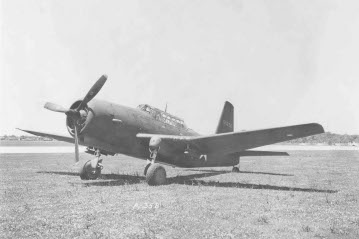![]() The Pacific War Online Encyclopedia
The Pacific War Online Encyclopedia
|
| Previous: A-28 Hudson, U.S. Medium Bomber | Table of Contents | Next: A1 Class, Japanese Submarines |

U.S. Air Force. Via National Museum of the U.S. Air Force
Vultee A-35B Vengeance
|
Crew |
2 | ||
|
Dimensions |
48'0" by 39'9" by
15'4" 14.63m by 12.11m by 4.67m |
||
|
Weight |
10,300-16,400 lbs 4672-7439 kg |
||
|
Maximum speed |
279 mph at
13,500 feet 449 km/h at 4115 meters |
||
| Cruise speed | 230
mph 370 km/h |
||
|
Climb rate |
20 feet per second 6.1 m/s |
||
|
Service ceiling |
22,000 feet 6800 meters |
||
| One 1700hp (1268 kW) Wright R-2600-13 Cyclone 14-cylinder radial driving a three bladed propeller. | |||
|
Armament |
6 0.50 machine guns in wings | ||
|
External stores |
One 2000 lb (900 kg) bomb | ||
|
Range |
600 miles (970
km) normal 2300 miles (3700 km) maximum |
||
| Fuel capacity |
275 gallons 317 liters |
||
| A total of 1931 by Vultee and Northrop (Hawthorne): | |||
| 400 | Mk.1 (A-31) | ||
| 200 | Mk.1A (A-31) | ||
| 300 | Mk.II (V-72) | ||
| 100 | Mk.III (A-31) | ||
| 831 | A-35B/Mk.IV | ||
| Variants |
The Mk.I was
armed with four 0.303
wing machine guns and two 0.303 rear machine guns. The Mk.II was armed with four 0.50 wing
machine guns and one 0.50 rear
machine gun. Models prior to Mk.IV used a 1600 hp (1193 kW) R-2600-19 engine. |
||
The Vultee Vengeance was built to British
specifications, entering production in 1942. It was not a
great design: Davenport Johnson described it as
"a shining example of the waste of material, manpower, and
time..." However, it saw some success in Burma.
The design team, led by Richard Palmer, received the
specification in July 1940, at a time when the capabilities of the dive
bomber as a ground support aircraft were inflated by the purported
successes of the German Ju-87
Stuka
in Europe. By the time the
first prototype flew in July 1941, the limitations of the dive bomber
were already beginning to be recognized, and by the time production
aircraft began to be delivered in November 1942 the Vultee was already
regarded as obsolescent.
About 342 were allocated to the Australians in
1942-1944, who employed them in New
Guinea until Kenney, who was deeply skeptical of dive bombing, ordered the dive bombers out of his theater.
Most were converted to target tugs by the various air forces that received them.
References
centuryofflight.net (accessed 2013-2-16)
Craven and Cate (1955; accessed 2014-6-7)
National Museum of the U.S. Air Force (accessed 2009-10-4)
The Pacific War Online Encyclopedia © 2007, 2009 by Kent G. Budge. Index